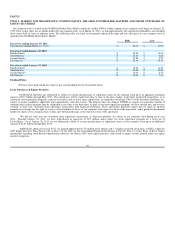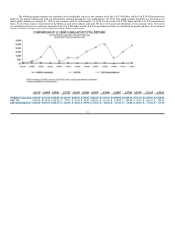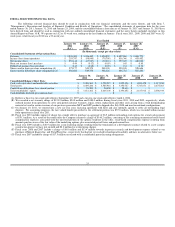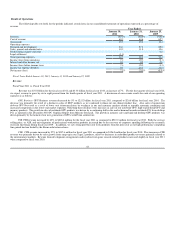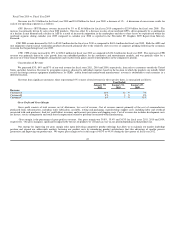NVIDIA 2011 Annual Report Download - page 36
Download and view the complete annual report
Please find page 36 of the 2011 NVIDIA annual report below. You can navigate through the pages in the report by either clicking on the pages listed below, or by using the keyword search tool below to find specific information within the annual report.
ITEM 7. MANAGEMENT’S DISCUSSION AND ANALYSIS OF FINANCIAL CONDITION AND RESULTS OF OPERATIONS
The following discussion and analysis of our financial condition and results of operations should be read in conjunction with “Item 1A. Risk Factors”,
“Item 6. Selected Financial Data”, our Consolidated Financial Statements and related Notes thereto, as well as other cautionary statements and risks described
elsewhere in this Annual Report on Form 10-K, before deciding to purchase, hold or sell shares of our common stock.
Overview
Our Company
NVIDIA Corporation invented the graphics processing unit, or GPU, in 1999. Since then, we have strived to set new standards in visual computing with
interactive graphics available on devices ranging from tablets and smart phones to notebooks and workstations. Our expertise in programmable GPUs and
computer-systems technology has led to breakthroughs in parallel processing which make supercomputing inexpensive and widely accessible. We are
strategically investing in three major areas – visual computing, high performance computing and mobile computing. We serve the visual computing market
with our consumer GeForce graphics products and professional Quadro graphics products; the high performance computing market with our Tesla computing
solutions products; and the mobile computing market with our Tegra system-on-chip products.
We have three primary financial reporting segments – GPU, Professional Solutions Business, or PSB and Consumer Products Business, or CPB. During
fiscal years 2010 and 2009, we operated and reported four major product-line operating segments: the GPU business, the PSB business, the media and
communications processor, or MCP, business, and the CPB business. However, during the first quarter of fiscal year 2011, we began reporting internally the
results of our former MCP segment along with the results of our GPU segment to reflect the way we manage the GPU business. Comparative periods
presented reflect this change.
Our GPU business is comprised primarily of our GeForce discrete and chipset products which support desktop and notebook personal computers, or PCs,
plus memory products. Our PSB is comprised of our Quadro professional workstation products and other professional graphics products, including our
NVIDIA Tesla high-performance computing products. Our CPB is comprised of our Tegra mobile products which support tablets, smartphones, personal
media players, or PMPs, internet television, automotive navigation, and other similar devices. CPB also includes license, royalty, other revenue and associated
costs related to video game consoles and other digital consumer electronics devices. Original equipment manufacturers, or OEMs, original design
manufacturers, or ODMs, add-in-card manufacturers, system builders and consumer electronics companies worldwide utilize our processors as a core
component of their entertainment, business and professional solutions.
We were incorporated in California in April 1993 and reincorporated in Delaware in April 1998. Our headquarter facilities are in Santa Clara, California.
Our web address is www.nvidia.com. The contents of our website are not a part of this Form 10-K.
Recent Developments, Future Objectives and Challenges
GPU Business
During fiscal year 2011, we took the computational capabilities of our GPUs to a new level with the launch of our Fermi architecture. Fermi GPUs
are designed to excel at tessellation, the key feature of DirectX 11, and to allow game developers to increase the level of physics realism via our PhysX API.
Our flagship product for the desktop, the GeForce GTX 480, was followed by a complete line-up of 400-series GPUs. Later in the year, we refreshed them
with our 500-series GPUs, which significantly increased the performance of the products they replaced while fitting into similar power envelopes. We also
launched 400M- and 500M-series GPUs for notebooks, along with our Optimus technology, which switches invisibly between discrete GPU and integrated
graphics controller depending on the user’s activities. By doing so, NVIDIA Optimus provides notebook users with the battery life of integrated graphics, but
with the gaming performance of a discrete graphics processor. PC manufacturers also are expected to launch hundreds of new PCs that use these new
GeForce GPUs paired with Intel Corporation’s Sandy Bridge CPUs.
During fiscal year 2011, we also announced our plans to develop a custom central processing unit, or CPU, that will use the ARM instruction set.
These CPU cores will be integrated into future generation GPUs for PCs, servers, and supercomputers.
34








